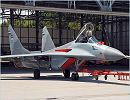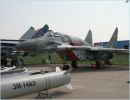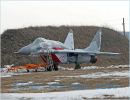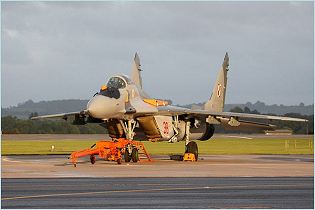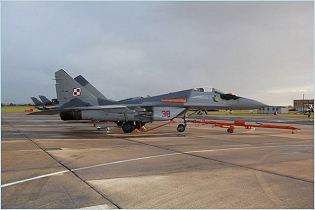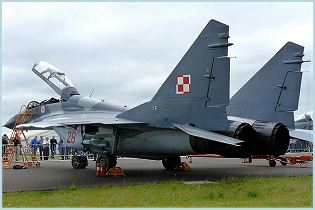MiG-29 Fulcrum Mikoyan
| a | ||||||||||||||||||||||
|
MiG-29 Fulcrum Mikoyan fighter aircraft
|
||||||||||||||||||||||
 |
||||||||||||||||||||||
|
a
|
||||||||||||||||||||||
|
The Mikoyan MiG-29 (NATO name Fulcrum) is a fourth-generation jet fighter aircraft designed and manufactured in Russia. Developed in the 1970s by the Mikoyan design bureau, it entered service with the Russian Air Force in 1983, and remains in use by the Russian Air Force as well as in many other nations. Intended to destroy air targets by day and night in VFR and IFR weather conditions and jamming environment, and to defeat ground (waterborne) targets. The MiG-29 was designed as a replacement for the MiG-21, MiG-23, Su-15 and Su-17 fighters. While its overall appearance is similar to that of the American F/A-18 Hornet, the MiG-29 incorporates much larger and deeper leading-edge root extensions (LERX) for good maneuverability at high angles of attack. |
||||||||||||||||||||||
| Main Variants | ||||||||||||||||||||||
|
|
||||||||||||||||||||||
|
|
||||||||||||||||||||||
|
||||||||||||||||||||||
|
|
||||||||||||||||||||||
|
||||||||||||||||||||||
|
|
||||||||||||||||||||||
|
||||||||||||||||||||||
|
|
||||||||||||||||||||||
|
||||||||||||||||||||||
|
|
||||||||||||||||||||||
|
||||||||||||||||||||||
|
|
||||||||||||||||||||||
| Technical Data | ||||||||||||||||||||||
| Design | ||||||||||||||||||||||
|
The MiG-29 is aerodynamically broadly similar to the Sukhoi Su-27, but with some notable differences. It is built largely out of aluminium with some composite materials. It has a mid-mounted swept wing with blended leading-edge root extensions (LERXs) swept at around 40°. There are swept tailplanes and two vertical fins, mounted on booms outboard of the engines. Automatic slats are mounted on the leading edges of the wings; they are four-segment on early models and five-segment on some later variants.
|
||||||||||||||||||||||
| Avionic | ||||||||||||||||||||||
|
The MiG-29 is equipped with an active jamming station. The avionics of MiG-29 was integrated NPO Elektroavtomatika with TsVM100.02.02 digital computer. Communication systems include R-862 Zhooravl-30, R-855UM Komar 2M emergency radio and SPU-9 intercom. Index 9.12A version has SRZ-1P interrogator and SRO-1P transponder, forming Parol-2D IFF system, while 9.12B has SRO-2 ('Odd Rods') IFF transponder and SRZ-15 interrogator. Two SO-69 ATC transponder antennas under conformal dielectric fairings in leading-edge of each wingroot extension. ALMAZ-UP cockpit voice recorder and voice warning system. Optional additional V/UHF radio.
The MiG-29 is equipped with the Phazotron RLS RP-29 (N019 Rubin) coherent pulse Doppler look- down/shoot-down engagement radar (NATO ' Slot Back'; able to track 10 targets simultaneously and engage one; search range 70 to 102 km depending on target size; tracking range 70 km; target tracking limits 38 km each side, with TS100 digital processor and integrated with OEPrNK-29 targeting/navigation complex including collimated OEPS-29 IRST/laser ranger. The cockpit has conventional dials, with a head-up display (HUD) and a Shchel-3UM helmet-mounted display for target designation system for off-axis aiming of air-to-air missiles. SEI-31 integrated display for radar and IRST information controlled by Tsl00.02.06 digital computer. |
||||||||||||||||||||||
| Propulsion | ||||||||||||||||||||||
|
The MiG-29 is powered by two Klimov/Sarkisov RD-33 turbofans, each 49.4 kN dry and 54.9-81.4 kN with afterburning. Engine ducts canted at approx 9 degrees, with wedge intakes, sweptback at approx 35 degrees, under wingroot leading-edge extensions. Multi-segment ramp system, including the top-hinged forward door inside each intake that doses the duct while aircraft is taking off or landing, to prevent ingestion of foreign objects, ice or snow. The engines provide a maximum speed of 2,400km/h at altitude and 1,500km/h near the ground and the service ceiling is 18,000m. The maximum range at altitude is 1,500km and 700km near the ground.
|
||||||||||||||||||||||
| Armament | ||||||||||||||||||||||
|
The MiG-29's suspendable weapons are arranged at six external store hardpoints and consist of:
- R-27-1 air-to-air medium-range missiles (up to 2); - R-73E air-to-air short-range missiles (up to 4); - S-8 rockets (up to 4 rocket pods) or S-24B rockets (up to 4); - aerial bombs weighing up to 2,000 kg in total. The original MiG-29 can carry general-purpose bombs and unguided rocket pods, but not precision-guided munitions. Upgraded models have provision for laser-guided and electro-optical bombs, as well as air-to-surface missiles. |
||||||||||||||||||||||
| Specifications | ||||||||||||||||||||||
|
||||||||||||||||||||||
 |
||||||||||||||||||||||
|
||||||||||||||||||||||



























